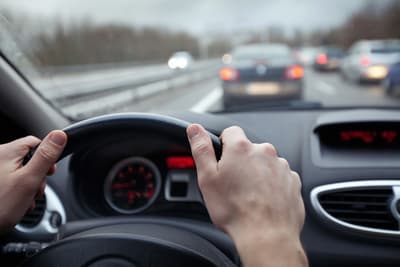How to Work Out Braking Distance With The Stopping Distance Formula

Were you aware that tailgating is one of the biggest causes of road traffic accidents in the UK? Knowing your car’s stopping distance in various conditions is an important part of staying safe on the roads and, because of this, stopping distance is part of the UK driving theory exam you must pass before getting a driver’s licence. Once the exam is completed though, it can easily be forgotten.
Refresh your knowledge of car stopping distances with our guide to working out braking distance with the stopping distance formula.
What is stopping distance?
Stopping distance refers to the distance travelled between you seeing a hazard and having stopped the car in reaction to it. It relies on a number of variables, so it will change depending on the speed you’re travelling, the weather and road conditions, and the alertness of the driver. However, just being aware of it will help you to stay at the right distance and speed.
The faster a car is travelling, the harder it is to stop quickly. Stopping distance is especially important in 30 mile per hour zones around schools, hospitals, and homes. When driving in these areas, ask yourself if you would be able to stop in time if somebody was to step out into the street.
Stopping distance = thinking distance + braking distance
What is thinking distance?
Thinking distance is the distance that you travel in your car from the point of detecting a hazard to the point of beginning to brake or swerve. Thinking time tends to be between 0.5 to 2 seconds, although this can increase if the driver is tired, distracted, or on medication. It is incredibly important that drivers remain alert and watchful at all times to minimise thinking distance.
Thinking distance is approximately 1 foot for every mph you travel at, for example, a car travelling at 30mph will travel 30 feet before the brakes are applied.
What is braking distance?
Braking distance is the distance you will travel between beginning to brake and the car coming to a complete stop. It is notoriously hard to calculate braking distance because road conditions and tyre grip can affect it so drastically. However, you can use the following tables as examples of stopping distances in average conditions.
How to work out stopping distance
Multiply the speed you are travelling at by intervals of 0.5, starting from 2:
| 20mph | x2 | 40 feet stopping distance |
| 30mph | x2.5 | 75 feet stopping distance |
| 40mph | x3 | 120 feet stopping distance |
| 50mph | x3.5 | 175 feet stopping distance |
| 60mph | x4 | 240 feet stopping distance |
| 70mph | x4.5 | 315 feet stopping distance |
To convert the stopping distance from feet to metres, divide the distance by 3.3:
| 40 feet stopping distance | ÷3.3 | 12 metres stopping distance |
| 75 feet stopping distance | ÷3.3 | 23 metres stopping distance |
| 120 feet stopping distance | ÷3.3 | 36 metres stopping distance |
| 175 feet stopping distance | ÷3.3 | 53 metres stopping distance |
| 240 feet stopping distance | ÷3.3 | 73 metres stopping distance |
| 315 feet stopping distance | ÷3.3 | 95metres stopping distance |
22 May 2019
Did you enjoy this blog post?
|
52 people found this review helpful
